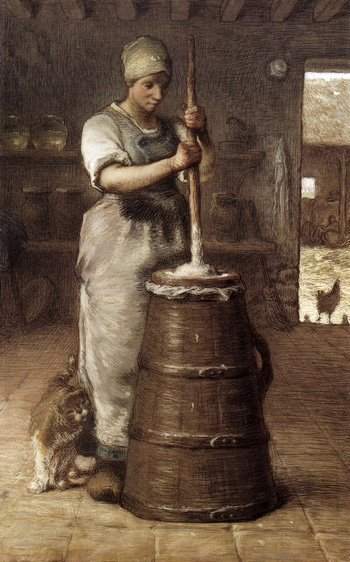 Carl Kahler (1855-1906) AUSTRIAN. MY WIFE’S LOVERS, signed C. Kahler (lower left), oil on canvas, 70 by 101 3/4 in (177.8 by 258.4 cm.)
Carl Kahler (1855-1906) AUSTRIAN. MY WIFE’S LOVERS, signed C. Kahler (lower left), oil on canvas, 70 by 101 3/4 in (177.8 by 258.4 cm.)
The massive artwork, which sits more than 8 feet wide and almost 6 feet tall, was commissioned by a cat lover Kate Birdsall Johnson in 1891 and painted by Austrian artist Carl Kahler. Named My Wife’s Lovers, completed in about three years, the painting features 42 cats — not a whole lot, considering that of Kate Birdsall Johnson owned some 350 cats, give and take a few. A number Birdsall’s cats that might not get into his main canvas were featured on Kahler’s other feline-themed paintings.
The cat came into the French painting in the early 17th century in the wake of the artists’ interest in everyday scenes, the mundane life of peasants and petty bourgeoisie. The cat came in quietly, gingerly and modestly settled on the edge of multi-figure paintings.
There she sits under a chair in Louis Le Nain’s “Visiting grandmother.” You hardly can see her, while the dog is depicted right in the center of the picture. And in the “peasant families” of the same Lenena its position is not the best – the cat was barely enough space in the lower corner of the picture.
And in the “Peasant Family” Le Nain lets the cat occupy barely enough space in the lower corner of the painting.
In the genre scenes of Francois Desportes the cat fights with the dog, both in the spotlight of the artist.
Feline subjects attracted the attention of an outstanding master of genre painting — Jean-Baptiste Chardin. Chardin saw poetry and intimacy in the daily life of the ordinary folks. Every object in his genre scenes depicted respectfully and thoughtfully. Kitchen utensils and an abundance of food was one of the favorite subjects of the artist, and what is kitchen without cats? Since cats draw attention of the best French artist of the time, cats, too, took their prominent place in the history of art:
“Natural man” of the Enlightenment era is not afraid of nature — he lives peacefully in harmony with the dogs, cats and sheep. Unpretentious pictures glorifying this simple life and bourgeois values becomes a kind of artistic manifesto.
The tradition of portraying “cats at the farm,” continued in the 19th century. One of the founders of the Barbizon school, Jean Francois Millet (1814 – 1875). .
In the second half of the 18th – 19th centuries cats moved from farms and kitchens to the living rooms or the boudoirs of affluent homes. One of the most prominent artists of the Rococo François Boucher (1703 – 1770) and Jean-Honoré Fragonard (1732 – 1806), as well as master of pastel portraiture of Jean-Baptiste Perronneau (c. 1715 – 1783), were captivated by feline grace and elegance and duly captured it on their respective canvases. Portraits of lovely ladies with pedigreed cats, genre scenes featuring elegant women and cats we find in abundance in French painting of this period.
Émile Munier (2 June 1840 – 29 June 1895) was a French academic artist and student of William-Adolphe Bouguereau.
Now, I’ll skip through a number of periods in the history of arts, straight to the Musical Cats of the famous French cartoonist and illustrator Claude-Henri Saunier. His kitties are known throughout the world: they adorn postcards, posters, books and magazines, invariably causing a smile and good humor.







